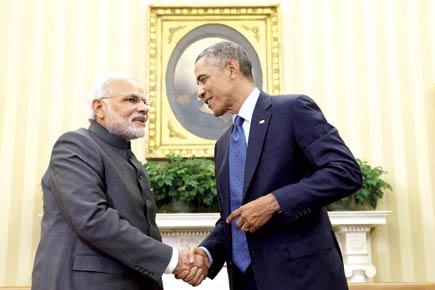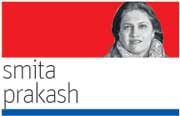It is more than a week since the prime minister has returned from the US and by norm, reporting should have whittled down, attention should have shifted to the Next Big Story, and follow-up should have been left to the babus of Delhi to do in ‘due course of time’

 It is more than a week since the prime minister has returned from the US and by norm, reporting should have whittled down, attention should have shifted to the Next Big Story, and follow-up should have been left to the babus of Delhi to do in ‘due course of time’.
It is more than a week since the prime minister has returned from the US and by norm, reporting should have whittled down, attention should have shifted to the Next Big Story, and follow-up should have been left to the babus of Delhi to do in ‘due course of time’.
ADVERTISEMENT
But, there is a new energy and urgency in the way things are done in the new government. Before, during, and after the US visit, high performance standards were set and met. Everybody on the team was highly motivated, equipped with technical skills and competence and if they didn’t, they either stepped aside or assisted in the best way that they could. Those who worked behind the scenes are terming it ‘a fantasy visit’ because of the high energy levels and higher adrenalin drives. From one meeting to another with a timetable on how to achieve, what and when, the focus was on deliverables. One bureaucrat remarked, “How could we even try to slow down when the PM would put in fourteen-hour days?”

In his meeting with President Obama at dinner, social media savvy guests that the US President had gotten around him immediately hit it off with the Indian Prime Minister, who chatted with them bewitchingly using social media jargon like ‘hashtags’ and ‘trends’. Pic/PTI
The American CEOs who met with Prime Minister Modi had to go through a rigorous selection process before they were granted a one-on-one appointment. In fact, as requests for appointments started pouring in at least two months before the PM’s arrival in the US, the interested CEOs were asked to present a plan of action on their economic outreach proposed for India, with specific reference to revenues, employment generation and growth prospects for the Indian economy. In some cases, American CEOs were asked to present a five-year plan. Sources say these plans were vetted by the PM and appointments were granted to those who had tangibles to offer.
As the initial homework had been done, the meetings of the American CEOs with the PM were focussed and to the point in terms of operational plans of moving forward. At each of the meetings, the PM began by asking what his government could do to enable the corporates concerned to get involved with the Indian economy.
It was also decided, based on the meetings, that the first review of next steps would be within 90 days, as the PM was determined to have deliverables within a fixed time. The message which went out was that India is serious about doing business so long as the American corporates involved were equally serious about their commitment to the Indian economy.
Another message that went out from India was that while policy frameworks on certain issues like the IPR (Intellectual Property Rights) were in the works, the government would swiftly resolve issues and concerns raised by the corporates concerned. American businesses are watching to see how India moves on second generation reforms, simplifying tax structures especially on retrospective taxation, issues like pharma, patents and WTO.
The Indian government’s style now is on getting the job done rather than on the process of getting there.
During the US visit, the delegation’s job was to find out what were the bottlenecks in moving ahead with joint projects; instructions were immediately issued to remove obstacles for mutual benefit, and a three-month timetable to execute projects. One of the CEOs who had run into red-tapism in an earlier manufacturing project was about to begin a rant when he was pre-empted by the prime minister who said he was well aware of what had happened, assured him in advance that he was dealing with a different outfit, a different way in which business would be conducted in India henceforth. The CEO was taken aback about the due diligence that had gone in before the meeting.
In his meeting with President Obama at dinner, social media savvy guests that the US President had gotten around him immediately hit it off with the Indian Prime Minister, who chatted with them bewitchingly using social media jargon like ‘hashtags’ and ‘trends’. The Indian Prime Minister narrated how he used social media during his election campaign with success and about his plans to connect India using different forms of media. The IT supremos, who had some inkling about the Indian PM being a master communicator, were clearly impressed with his intricate knowledge of communication tools. Indian Foreign Service officials at the dinner, like President Obama, watched this interaction with bemusement.
The PM’s foreign visits have enhanced his reputation of being an efficient administrator and competent manager. He is a hard taskmaster, and has initiated a new work culture that the Indian executive is just about coming to terms with. Many are watching to see if this momentum will sustain.
Smita Prakash is Editor, News at Asian News International. You can follow her on twitter @smitaprakash
 Subscribe today by clicking the link and stay updated with the latest news!" Click here!
Subscribe today by clicking the link and stay updated with the latest news!" Click here!






